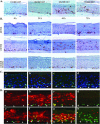Conditionally activated E7 proteins of high-risk and low-risk human papillomaviruses induce S phase in postmitotic, differentiated human keratinocytes
- PMID: 16775338
- PMCID: PMC1488939
- DOI: 10.1128/JVI.02499-05
Conditionally activated E7 proteins of high-risk and low-risk human papillomaviruses induce S phase in postmitotic, differentiated human keratinocytes
Abstract
The productive program of human papillomaviruses (HPVs) in epithelia is tightly linked to squamous differentiation. The E7 proteins of high-risk HPV genotypes efficiently inactivate the pRB family of proteins that control the cell cycle, triggering S phase in suprabasal keratinocytes. This ability has until now not been demonstrated for the low-risk HPV-6 or HPV-11 E7 proteins. An inducible system in which HPV-16 E7 is fused to the ligand binding domain of the human estrogen receptor (ER) was described by Smith-McCune et al. (K. Smith-McCune, D. Kalman, C. Robbins, S. Shivakumar, L. Yuschenkoff, and J. M. Bishop, Proc. Natl. Acad. Sci. USA 96:6999-7004, 1999). In the absence of hormone, E7ER is cytoplasmic, and upon addition of 17beta-estradiol, it translocates to the nucleus. Using organotypic epithelial raft cultures developed from primary human keratinocytes, we show that 16E7ER promotes either S-phase reentry or p21cip1 accumulation in differentiated keratinocytes in a stochastic manner as early as 6 h postinduction with 17beta-estradiol. A vector expressing the ER moiety alone had no effect. These observations prove unequivocally that the E7 protein drives S-phase reentry in postmitotic, differentiated keratinocytes rather than preventing S-phase exit while the cells ascend through the epithelium. HPV-11 E7ER and, much less efficiently, HPV-6 E7ER also promoted S-phase reentry by differentiated cells upon exposure to 17beta-estradiol. S-phase induction required the consensus pRB binding motif. We propose that the elevated nuclear levels of the low-risk HPV E7 protein afforded by the inducible system account for the positive results. These observations are entirely consistent with the fact that low-risk HPV genotypes replicate in the differentiated strata in patient specimens, as do the high-risk HPVs.
Figures




References
-
- Armstrong, D. J., and A. Roman. 1992. Mutagenesis of human papillomavirus types 6 and 16 E7 open reading frames alters the electrophoretic mobility of the expressed proteins. J. Gen. Virol. 73:1275-1279. - PubMed
-
- Banerjee, N. S., L. T. Chow, and T. R. Broker. 2005. Retrovirus mediated gene transfer to analyze HPV gene regulation and protein functions in “organotypic” raft culture, p. 187-202. In C. Davy and J. Doorbar (ed.), Human papillomaviruses: methods and protocols, methods in molecular medicine. Humana Press, Totowa, N.J. - PubMed
-
- Cheng, S., D.-C. Schmidt-Grimminger, T. Murant, T. R. Broker, and L. T. Chow. 1995. Differentiation-dependent up-regulation of the human papillomavirus E7 gene reactivates cellular DNA replication in suprabasal differentiated keratinocytes. Genes Dev. 9:2335-2349. - PubMed
-
- Chien, W.-M., J. N. Parker, D.-C. Schmidt-Grimminger, T. R. Broker, and L. T. Chow. 2000. Casein kinase II phosphorylation of the human papillomavirus-18 E7 protein is critical for promoting S-phase entry. Cell Growth Differ. 11:425-435. - PubMed
Publication types
MeSH terms
Substances
Grants and funding
LinkOut - more resources
Full Text Sources

